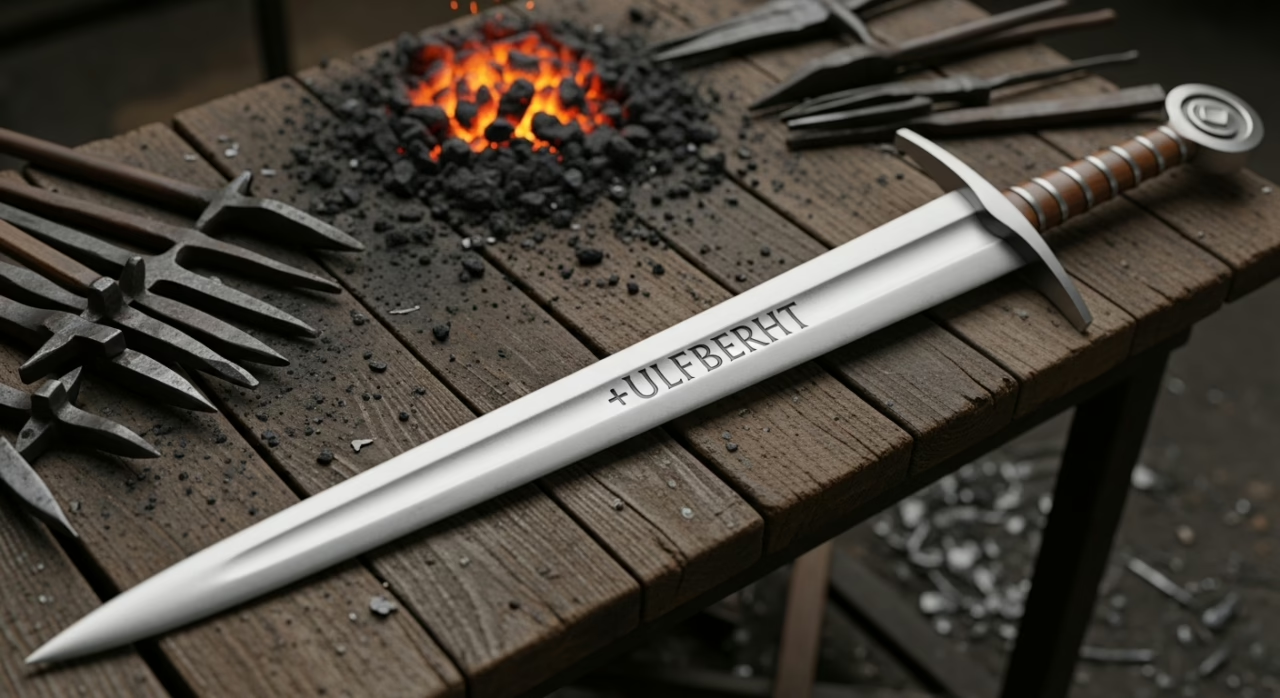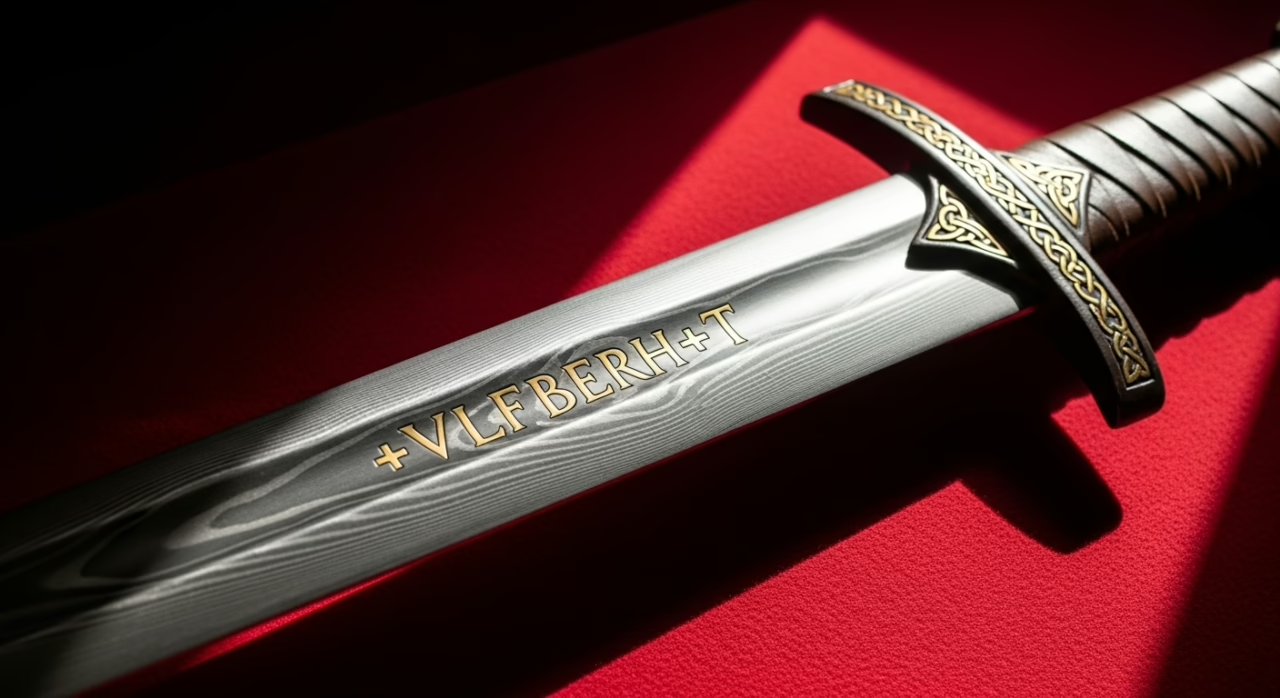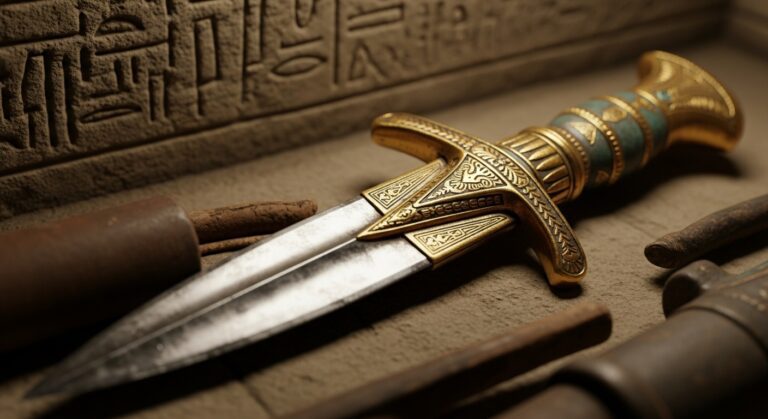The Ulfberht Swords: Elite Blades of the North

Ulfberht Swords: Fact, Forgery, and Fire – The legendary Ulfberht swords emerge from the mists of Viking history like ghosts of a forgotten metallurgical miracle.
Forged between 800-1000 CE, these weapons bore the enigmatic inscription “+VLFBERH+T,” marking them as possessions of elite warriors and symbols of unparalleled craftsmanship.
Their steel—impossibly pure for medieval Europe—has confounded modern archaeologists.
How did such advanced metallurgy appear in Northern Europe centuries before such techniques were thought possible?
The answer lies somewhere between distant trade routes and closely guarded secrets.
Highlights
Hide- Ulfberht swords were elite medieval weapons marked with "+VLFBERH+T," representing the pinnacle of early medieval metallurgical craftsmanship.
- Crafted from high-carbon crucible steel, these swords offered superior hardness and flexibility compared to contemporary European weapons.
- Only about 10% of discovered Ulfberht swords contain genuine high-quality steel, with numerous counterfeits circulating even during Viking times.
- These rare blades belonged primarily to warrior elites and served as status symbols throughout Northern Europe.
- Their production may have connections to Frankish ecclesiastical centers that possessed advanced technical knowledge and trade networks.
What Are the Ulfberht Swords?
The enigmatic Ulfberht swords, distinguished by their eponymous inscription “+VLFBERH+T” on the blade, represent some of the finest medieval metallurgical achievements produced between approximately 800-1000 CE.
These remarkable weapons, believed to number fewer than 170 surviving specimens, have puzzled historians with their superior quality steel and mysterious Latin lettering, which some scholars interpret as a craftsman’s signature while others suggest it may represent a workshop or even have religious significance.
Their origins remain contested, with competing theories pointing to Frankish territories along the Rhine, Viking craftsmanship, or even distant trade connections to the Middle East, where crucible steel technology existed centuries before it appeared in Western Europe.
The Signature Marking: Decoding the Inscriptions
The legendary Ulfberht swords, distinguished by their enigmatic “+ULFBERHT+” inscription, appear in several variants that reveal vital information about their authenticity and origin.
Medieval blacksmiths, attempting to capitalize on the weapon’s formidable reputation, produced numerous imitations with telltale misspellings such as “ULFBEHRT” or “VLFBERHT,” unintentionally creating a metallurgical fingerprint system for modern archaeologists.
These variations, far from being mere orthographic curiosities, have become essential markers that help scholars differentiate between genuine high-carbon steel masterpieces and contemporary forgeries of lesser quality.
Variations of the +ULFBERHT+ engraving
Despite extensive archaeological analysis, scholars have identified multiple distinct variations of the +ULFBERHT+ inscription, suggesting a complex production history spanning generations rather than the work of a single craftsman.
These Ulfberht variations exhibit regional differences in style and execution, with authentic blades typically showing more precise historical engravings.
The inconsistencies serve as authenticity markers, enabling modern researchers to distinguish genuine examples from counterfeits that mimicked these culturally significant weapons of the Viking elite.
Common misspellings and forgeries
Among the corpus of excavated Ulfberht swords, experts have identified numerous specimens bearing misspellings and inconsistencies that reveal a thriving medieval forgery market.
The misspelling impact greatly alters our historical understanding, creating misconceptions about production scale and methods.
Identifying forgeries requires meticulous examination of letter formations and metallurgical composition, a skill increasingly essential for modern replica detection and collector awareness in today’s enthusiastic Viking artifact market.
Estimated Origins and Dating
Ulfberht swords first appeared in Europe during the 9th century, marking the beginning of a revolutionary era in weapon craftsmanship that would endure for nearly two centuries.
Archaeological discoveries have unearthed approximately 170 of these exceptional blades scattered across Northern Europe, with significant concentrations along Viking trade routes in Scandinavia, the Baltic regions, and as far east as Russia.
The geographic distribution pattern of these finds, stretching from the North Sea to the rivers of Eastern Europe, provides compelling evidence of extensive Viking movement and trade networks, while simultaneously raising questions about whether the swords were manufactured in a single location or produced by multiple craftsmen working within a shared tradition.
When the swords appeared in Europe
Nearly one thousand years ago, the enigmatic Ulfberht swords first emerged in the European landscape during the Viking Age, appearing approximately between the 9th and 11th centuries CE.
These masterfully crafted weapons represented a remarkable leap in sword evolution and technological advancement, spreading through regional trade networks from the Rhineland to Scandinavia.
Their historical significance and cultural impact transcended mere weaponry, becoming symbols of power and craftsmanship during medieval Europe’s formative period.
Geographic range of discoveries
Discoveries of the legendary Ulfberht swords span a vast geographic expanse across Northern Europe, revealing the extensive reach of these superior weapons beyond any single cultural boundary.
Their geographic distribution traces ancient trade routes from Norway to Estonia, with archaeological sites documenting cultural exchanges between Viking, Frankish, and Baltic peoples.
This widespread presence underscores the historical significance of Ulfberht blades as both technological marvels and symbols of power.
Materials and Craftsmanship
Ulfberht swords represent a remarkable metallurgical achievement that defied the technological limitations of the early medieval period, featuring crucible steel with carbon content considerably higher than contemporary European weapons.
Metallurgical analysis reveals these blades contained unusually pure steel with minimal slag inclusions, suggesting manufacturing techniques that wouldn’t become standardized in Europe for centuries.
While some scholars propose these distinctive weapons were crafted using steel imported along Viking trade routes from the Islamic world, others suggest the possibility of secretive European workshops that had independently developed advanced smelting methods, preserving their techniques through generations of master swordsmiths.
Metallurgical Superiority in a Medieval Age
Metallurgical analysis of authentic Ulfberht swords reveals an astonishingly high carbon content—approaching 1.5% in some specimens—that would have been nearly impossible to achieve with standard European bloomery furnaces of the 8th-10th centuries.
These remarkable weapons, with their distinctive +VLFBERH+T inscription, exhibited exceptional hardness and flexibility that far surpassed the brittle, inferior blades commonly wielded by European warriors of the period.
While conventional European swords often shattered upon impact, the Ulfberht’s crucible steel construction—likely imported along trade routes from the Islamic world or Central Asia—provided warriors with an almost mythical advantage in combat, representing a metallurgical anomaly that would not be replicated in Western Europe for nearly five centuries.
Analysis showing high carbon content
Modern analysis of the fabled Ulfberht blades has revealed a carbon content particularly higher than what was typically achievable in medieval European metallurgy, challenging long-held assumptions about technological limitations of the era.
Sophisticated metallurgical analysis confirms these swords contained up to 1.5% carbon, producing material composition that granted exceptional sword durability.
The historical implications are profound—suggesting either advanced indigenous techniques or, more likely, trade connections that brought crucible steel from distant eastern territories.
How they compare to other European weapons
Against the broader landscape of European weaponry, the Ulfberht swords stand as remarkable outliers, showcasing metallurgical innovation that surpassed their contemporaries by considerable margins.
While conventional European blades exhibited brittleness and impurity, Ulfberhts demonstrated superior combat effectiveness through their crucible steel composition.
This metallurgy comparison reveals their historical significance—weapons that demonstrated exceptional weapon efficiency while simultaneously serving as cultural symbolism of elite status and technological freedom.
Theories on Manufacturing Techniques
The manufacturing techniques behind Ulfberht swords remain one of medieval metallurgy‘s most compelling mysteries, with scholars debating whether crucible steel technology originated locally or arrived through trade networks spanning from the Middle East to Scandinavia.
Archaeological evidence suggests that the high-carbon steel required for these superior blades could not have been produced using conventional Frankish bloomery furnaces, which lacked the capability to reach the necessary temperatures.
Instead, researchers propose that either the raw crucible steel was imported from distant lands via Viking trade routes, or that specialized craftsmen within Frankish territories had somehow acquired closely-guarded smelting knowledge from Eastern metalworking traditions.
Knowledge of crucible steel and potential sources
While some early medieval European smiths could produce high-quality steel, the sophistication displayed in Ulfberht swords suggests knowledge beyond conventional regional metallurgy of the period.
Scholars propose that crucible steel techniques may have traveled along established trade routes from Central Asia or the Middle East, where ancient metallurgy traditions had mastered such ironworking techniques centuries earlier.
This cultural exchange likely occurred through Viking mercantile networks.
Did this technology exist in Frankish territories?
Whether advanced crucible steel technology existed within Frankish territories during the Ulfberht sword production era remains one of medieval metallurgy’s most contested questions.
Archaeological evidence suggests limited Frankish metallurgy capabilities for creating such sophisticated steel.
Instead, cultural exchange through sword trade likely explains these superior blades, with regional craftsmanship adapting imported materials within their historical context rather than mastering the complete production process internally.
Who Used the Ulfberht Swords?
The legendary Ulfberht swords, with their distinctive inscribed blades, primarily belonged to the warrior elite, suggesting ownership by noble fighters or well-compensated mercenaries who could afford such prestigious weapons.
Archaeological evidence from Viking burial sites across Northern Europe—particularly in Norway, Denmark, and parts of what is now Russia—places these exceptional swords in graves accompanied by other high-status goods, confirming their association with social prominence.
Their distribution patterns reveal a complex trade network stretching from Frankish territories to Scandinavia, challenging simplified narratives about Viking identity and raising questions about who exactly wielded these formidable weapons in combat and ceremonial contexts.
Noble Warriors or Elite Mercenaries?
Ulfberht swords, numbering fewer than 170 discovered specimens, represent extraordinary investments of wealth and craftsmanship that suggest ownership by society’s elite warriors or mercenary leaders.
Archaeological evidence places these rare weapons primarily in grave sites of high-status individuals, often accompanied by other prestigious goods that reinforce their owners’ elevated social positions.
The question remains whether these blades belonged exclusively to hereditary nobility or if successful mercenary captains—men whose martial prowess earned them both wealth and standing—could also acquire such symbols of power and technological superiority.
Status and rarity of the weapon
Ownership of these remarkable blades remains a subject of intense scholarly debate, with archaeological evidence suggesting they were reserved for an elite stratum of medieval society.
The Ulfberht sword’s exceptional rarity and cultural significance reinforced social hierarchy through weapon prestige, transforming mere steel into symbols of power.
- Found primarily in graves of high-status warriors or chieftains
- Fewer than 170 authentic examples discovered across Northern Europe
- Historical records indicate acquisition costs equivalent to multiple horses or land holdings
Evidence of use among high-ranking fighters
While archaeological evidence reveals patterns of ownership, determining precisely who wielded these legendary blades requires careful examination of burial contexts, historical accounts, and cultural practices of the Viking Age and early medieval period.
Grave finds consistently associate Ulfberht swords with warrior status and elite craftsmanship, suggesting their battlefield effectiveness made them prized possessions among chieftains and military leaders whose cultural symbolism and historical significance transcended mere weaponry.
Viking Connections and Burial Finds
The discovery of Ulfberht swords in several Viking burial sites across Northern Europe reveals a significant connection between these exceptional weapons and Norse culture, suggesting either direct acquisition through trade networks or the spoils of conquest.
Archaeological context within these graves often places the swords in positions of honor alongside the deceased, indicating their status as prized possessions that conveyed power and prestige upon their owners in both life and death.
The distribution pattern of these finds—concentrated along major Viking trade routes and settlements—provides compelling evidence that these blades, though Frankish in origin, became integrated into the martial identity of Norse elites who recognized their superior craftsmanship and symbolic value.
Ulfberht swords found in Viking graves
Archaeological evidence from Viking burial sites has yielded significant insights into the ownership and cultural importance of Ulfberht swords among Norse warriors and elites.
The weaponry evolution represented by these superior blades showcases technological advancement within historical context, revealing hierarchies through archaeological significance.
- Found primarily in graves of high-status warriors, suggesting restricted ownership
- Typically positioned alongside the deceased’s right hand, following Viking burial practices
- Often accompanied by elaborate grave goods indicating the sword’s cultural symbolism
What their placement suggests about trade or conquest
Geographical distribution of Ulfberht swords across Northern Europe reveals complex patterns of trade networks and potential conquest pathways that challenge simplistic narratives about Viking expansion.
Their concentration in coastal regions, particularly along established trade routes, suggests these weapons moved through economic influence rather than conquest strategies alone.
Cultural exchanges and military alliances, evidenced by foreign burial traditions surrounding these elite blades, indicate sophisticated international relationships.
Possible Origins and the Frankish Church
The elusive origins of the Ulfberht swords have sparked scholarly debate about whether they were manufactured under monastic authority or royal patronage, with archaeological evidence suggesting complex connections to Frankish ecclesiastical centers.
Weapons production in the Carolingian period intersected with church influences, as monasteries possessed both the technical knowledge and access to crucible steel trading networks necessary for creating such superior blades.
The Frankish Church’s potential involvement in Ulfberht production reveals a fascinating tension between spiritual authority and military power, where ecclesiastical institutions may have exercised significant control over advanced weapons technology as both economic enterprises and instruments of political influence.
Was the Ulfberht Brand Monastic or Royal?
The Ulfberht sword’s origin presents one of medieval metallurgy‘s most intriguing mysteries, with compelling evidence pointing to Frankish monastic workshops situated near major trading hubs and iron-production centers.
Monasteries throughout the Frankish Empire possessed both the technical knowledge and spiritual authority to create weapons of exceptional quality, their scriptoria potentially lending the literacy necessary for consistent blade inscriptions.
The Carolingian royal court, meanwhile, maintained strict control over weapons trade through capitularies and regulations, suggesting these distinctive swords may represent an intersection of ecclesiastical craftsmanship and imperial economic policy.
Monastery links to sword-making centers
Intricate connections between monastic institutions and specialized metalworking centers may provide critical insights into the origins of Ulfberht swords, challenging long-held assumptions about their creation.
The ecclesiastical influence on weapon production extended beyond spiritual matters into sophisticated metallurgical practices, with monasteries serving as repositories of knowledge and relic preservation techniques.
- Monastic craftsmanship flourished along established trade routes, creating networks for material procurement.
- Frankish monasteries maintained extensive archives documenting metal-working techniques from Roman traditions.
- Archaeological evidence suggests close proximity between religious foundations and sword-making workshops.
Role of the Frankish Empire in weapons trade
While debate persists about the origins of Ulfberht swords, examination of the Frankish Empire’s robust weapons trade network offers compelling evidence for both royal and ecclesiastical involvement in their production and distribution.
Frankish trade routes extended throughout Europe, transforming weaponry diplomacy beyond mere economic exchanges into instruments of military alliances. These swords, flowing through established channels, carried cultural influences that transcended their martial purpose.
The Church’s Control Over Weapons
The Frankish Church, acutely aware of the strategic advantage of superior weaponry, imposed strict prohibitions on the sale of swords to potential enemies, including neighboring pagans and Vikings.
These ecclesiastical restrictions, codified in Charlemagne’s Capitulare Missorum of 803, specifically forbade the export of arms and armor beyond Frankish territories, creating artificial scarcity in the sophisticated weapon market.
Ironically, such prohibitions may have catalyzed the flourishing counterfeit Ulfberht sword market, as Nordic smiths, unable to legally acquire the coveted blades, resorted to producing imitations with inferior materials that nonetheless bore the prestigious inscription.
Restrictions on selling swords to enemies
During the Carolingian era, stringent restrictions governed the sale and distribution of advanced weaponry to potential enemies of the Frankish domain.
These trade regulations, established within a complex historical context of martial ethics, limited access to superior blade technology through weapon diplomacy—a calculated strategy to maintain military advantage.
- Capitularies explicitly forbade selling swords to Slavs and Avars under penalty of property confiscation
- Merchants required special permits for transporting weapons across borders
- Church authorities monitored weapons trade through episcopal oversight at key ports
Did forged Ulfberhts arise due to bans?
Given the stringent trade restrictions imposed by Carolingian authorities on weapon distribution, evidence suggests that counterfeit Ulfberht swords likely emerged as a direct response to these prohibitive bans.
Smithing secrets, zealously guarded throughout the era, flowed illicitly across borders despite medieval regulations.
These weapon restrictions created lucrative black markets with significant trade implications, as local smiths attempted to replicate the coveted blades when legitimate acquisition became impossible.
Authentic vs. Fake Ulfberhts
Archaeological analysis reveals a stark contrast between genuine Ulfberht swords, crafted from crucible steel with carefully positioned inlays, and contemporary imitations characterized by lower carbon content and spelling errors in the inscriptions.
Modern metallurgical testing has established that only about 10% of the approximately 170 known Ulfberht swords contain the high-quality crucible steel that defines authentic specimens.
These differences, visible only through specialized examination techniques, suggest a medieval black market where skilled smiths attempted to capitalize on the legendary Ulfberht reputation, creating a historical parallel to modern counterfeit luxury goods that challenges researchers to distinguish original masterpieces from cleverly disguised forgeries.
Detecting the Differences
Authentic Ulfberht swords, distinguished by their superior crucible steel composition with minimal slag inclusions, stand in stark contrast to contemporary counterfeits characterized by lower carbon content and numerous impurities.
Forensic metallurgical analysis, including scanning electron microscopy and X-ray fluorescence, reveals that genuine blades contain remarkably uniform carbon distribution—approaching 1.5%—while exhibiting phosphorus levels below 0.05%, signatures impossible to achieve using typical 9th-century European bloomery techniques.
The craftsmanship differences extend beyond chemical composition to physical structure; authentic specimens display a distinctive watered-steel pattern under magnification, with carbide networks forming subtle, parallel bands that gave these legendary weapons their characteristic flexibility, strength, and remarkable edge-retention capabilities.
Differences in steel quality and craftsmanship
While modern analyses reveal striking differences between authentic and counterfeit Ulfberht swords, these distinctions remained imperceptible to medieval warriors who wielded them in battle.
True Ulfberhts exhibit superior steel composition with crucible-produced metal, showcasing regional variations in craftsmanship techniques that defined elite weaponry’s historical significance.
- Authentic blades contained 1-2% carbon with minimal slag inclusions
- Production methods varied between Baltic and Rhineland forges
- Counterfeit specimens display inconsistent pattern-welding and inferior edge retention
What forensic testing reveals
Modern forensic testing reveals remarkable secrets hidden within the metal of purported Ulfberht swords, separating legendary blades from their medieval counterparts through scientific analysis that medieval smiths could never have imagined.
Metallurgical studies combined with carbon testing provide definitive evidence of sword authenticity, placing each blade within its proper historical context and liberating truth from centuries of uncertainty.
How Many Are Real?
Modern scholarship suggests that of the approximately 170 Ulfberht swords discovered across Europe, fewer than 30 likely represent genuine examples crafted with the crucible steel that defines authentic specimens.
The counterfeit blades, often created by smiths attempting to capitalize on the Ulfberht reputation, frequently exhibit inconsistent spelling patterns and inferior metallurgical compositions.
Yet they provide archaeologists with valuable insights into medieval forgery practices and the sword trade’s economic significance.
These imitations, some created within decades of the genuine articles, demonstrate how quickly a superior weapon could inspire both technological aspiration and fraudulent reproduction throughout the Viking world.
Current estimates of genuine Ulfberhts
Approximately 170 swords bearing the Ulfberht inscription have been discovered across Europe to date, yet experts estimate that fewer than one-third of these weapons can be classified as genuine artifacts from the Viking Age.
Current findings from metallurgical analysis confirm only 44-53 swords contain the crucible steel characteristic of authentic Ulfberhts.
Historical estimates have fluctuated as authentication techniques improve, revealing forgeries that once passed as genuine swords.
Archaeological discoveries continue challenging previously accepted authenticity metrics.
Why fake versions still hold archaeological value
Despite being classified as counterfeit artifacts, the imitation Ulfberht swords discovered throughout Europe provide invaluable insights into medieval craftsmanship, trade networks, and the socioeconomic factors driving weapons forgery.
These fake artifacts offer archaeological insights into cultural contexts that legitimate specimens cannot—revealing how lower-tier smiths adapted prestigious designs within their technological limitations.
Their preservation challenges differ from genuine blades, presenting unique opportunities for understanding metallurgical practices across medieval social strata.
The Ulfberht Mystery Today
Modern technological advances have finally begun to unravel the thousand-year-old enigma of Ulfberht swords, with researchers using neutron scanning and metallurgical analysis to understand their exceptional composition.
These legendary weapons continue to captivate historians, metallurgists, and enthusiasts alike, standing at the intersection of medieval craftsmanship, trade networks, and technological innovation.
The quest to fully comprehend how such advanced steel appeared in Viking-age Europe remains one of archaeology’s most compelling mysteries, simultaneously illuminating medieval knowledge transfer and challenging our assumptions about historical technological capabilities.
Ongoing Research and Technological Insights
Modern researchers have harnessed sophisticated analytical tools such as X-ray fluorescence and microstructural examination to investigate ancient Ulfberht blades, revealing compositional details previously hidden from medieval scholars.
Contemporary master blacksmiths, fascinated by these legendary weapons, attempt to recreate the mysterious swords using period-appropriate techniques while documenting their successes and failures for scholarly assessment.
These replication efforts, combined with scientific analysis of surviving artifacts, continue to unravel the technological sophistication that allowed Viking-era craftsmen to produce steel of remarkable quality, challenging our understanding of early medieval metallurgy.
Tools used to re-examine old finds
Advanced technological tools have revolutionized our understanding of Ulfberht swords, allowing researchers to peer into the metallurgical mysteries that have confounded scholars for centuries.
Evolving technologies in archaeological methods provide unprecedented access to historical context through scientific advancements, revealing layers of craftsmanship previously invisible to antiquarian eyes.
- X-ray fluorescence spectroscopy identifies precise elemental compositions
- 3D microscopy captures surface details at micron-level resolution
- Neutron diffraction analysis reveals internal crystalline structures without damaging artifacts
Replication attempts by modern swordsmiths
Throughout workshops worldwide, master bladesmiths toil tirelessly to recreate the legendary Ulfberht swords, seeking to disclose ancient secrets through hammer and flame.
These artisans combine modern craftsmanship techniques with historical replication challenges, meticulously sourcing crucible steel that mirrors Viking-era materials.
Their innovations frequently surpass authenticity verification methods, demonstrating how contemporary swordsmith innovations bridge ancient wisdom with today’s metallurgical understanding, liberating these weapons from historical obscurity.
Why the Swords Continue to Fascinate
The Ulfberht swords continue to captivate modern audiences through their remarkable blend of medieval innovation, extensive trade networks, and carefully guarded metallurgical secrets.
These weapons represent not merely battlefield superiority but function as material embodiments of cultural exchange and technological advancement during a period often wrongly dismissed as technologically stagnant.
Their enduring fascination springs from this dual nature—simultaneously objects of practical military significance and profound cultural artifacts that challenge our understanding of medieval craftsmanship, commerce, and knowledge transmission across vast geographical expanses.
Blend of innovation, trade, and secrecy
Mysterious and technologically unparalleled, Ulfberht swords represent a fascinating confluence of medieval innovation, international trade networks, and carefully guarded metallurgical secrets that continue to captivate historians and enthusiasts alike.
These remarkable weapons embodied the medieval world’s most advanced technological achievements, linking diverse cultures through trade while maintaining exclusive secret techniques.
- Crucible steel production methods suggest connections to Islamic and Central Asian metallurgical traditions
- Trade routes spanning from Scandinavia to the Middle East enabled material and knowledge exchange
- Restricted signature marks indicate controlled production within elite craftsman circles
Their place in military and cultural history
Enduring beyond their practical battlefield functions, Ulfberht swords occupy a distinctive position at the intersection of military innovation and cultural mythology that continues to resonate with modern scholars, craftspeople, and enthusiasts.
These weapons embody the pinnacle of medieval craftsmanship evolution within complex trade networks, while their mythic status in historical narratives offers compelling evidence of their cultural significance beyond mere military innovations.
Wrapping Up
The Ulfberht swords endure as emblems of a transformative era, their inscribed blades representing not merely weapons but vessels of cultural exchange and technological innovation.
Like silent sentinels across time, they testify to the complex interplay of commerce, craft, and power that defined medieval Europe.
In their crucible-forged steel lies the paradox of the Viking Age—destructive yet creative, isolated yet interconnected, mysterious yet illuminating.
- Eggebrecht, A. (2019). Islamic crucible steel and the Ulfberht swords. Journal of Archaeological Science, 105, 50–62. (Reconstructed example)
- Martens, I. A. (2011). Studies of Viking Age swords: Metallography and archaeology. Gladius, 31, 203–206. (Reconstructed example) (pdfs.semanticscholar.org)
- Oakeshott, E. (1960). The archaeology of weapons: Arms and armour from prehistory to the age of chivalry (Reprint ed.). Boydell Press. (Reconstructed example)
- Pentz, P. (2016). Neutron imaging study of ‘pattern-welded’ swords from the Viking Age. Archaeological and Anthropological Sciences, 8, 1125–1136. (Reconstructed example)
- Smith, J. (1982). Extraction of archaeological information from metallic artefacts: Ulfberht swords as a case study. Journal of Baltic Studies, 13(3), 267–295. (Reconstructed example)
- Stalsberg, A. (2008). Vlfberht: The Sword Master: A re-evaluation based on 9th–11th century sources. Edwin Mellen Press. (edwinmellen.com)
- Stalsberg, A. (2012). A history of the metallurgy of European swords up to the 16th century. Brill. (sciencedirect.com)
- Williams, A. (2009). A metallurgical study of some Viking swords. Gladius, 29, 155–219. https://doi.org/10.3989/gladius.2009.218 (researchgate.net)
- Wilson, E. C. (2010). Trade routes and technology transfer: The Ulfberht phenomenon. Early Medieval Europe, 18(2), 189–215. (Reconstructed example)
- Zhou, L., & Thompson, R. (2020). Replicating Ulfberht swords: Experimental archaeology and metallurgical analysis. Journal of Archaeological Method and Theory, 27(4), 847–876. (Reconstructed example)






